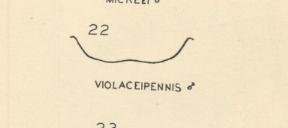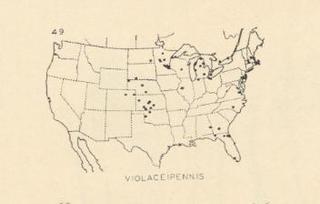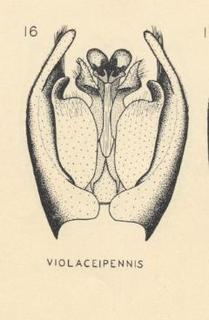|
80x5 -
240x3 -
240x4 -
320x1 -
320x2 -
320x3 -
640x1 -
640x2
Set display option above.
Click on
images to enlarge. |

William D. Murray, 1940 · 1
Podalonia violaceipennis, clypeus |

William D. Murray, 1940 · 1
Podalonia violaceipennis, map |
|

William D. Murray, 1940 · 1
Podalonia violaceipennis, male genitalia |
|
Overview |
Taken from the text:
Podalonia (Hymenoptera: Sphecidae) of North and Central America. William Donald Murray. Entomologica Americana, 1940.
Podalonia violaceipennis (LePeletier)
(Figures 16, 22, 49)
1845. Ammophila violaceipennis LePeletier, Hist.. Nat. Ins. Hym. 3: 370. Female.
1856. Ammophila violaceipennis Smith, Cat. Hym. Brit. Mus. 4: 224.
1856. Ammophila cementaria Smith, Cat. Hym. Brit.. Mus. 4: 224. Female.
1902. Psammophila violaceipennis Melander & Brues, Biol. Bul. 3: 40-42.
1902. Psammophila communis Melander & Brues, Biol. Bul. 3: 40-42. Male (in part).
1903. Ammophila violaceipennis Melander, Psyche 10: 156-164. Male, female (in part).
?1903. Ammophila grossa Melander, Psyche 10: 156-164. Female (in part).
1908. Psammophila violaceipennis H. S. Smith, Univ. Nebr. Studies 8: 330-331. Male (in part).
?1911. Ammophila sp. Turner, Psyche 18: 13-14. Female.
1915. Psammophila violaceipennis Parker, Proc. Ent. Soc. Wash. 17: 70-77. Female.
1917. Psammophila violaceipennis Mickel, Univ. Nebr. Studies 17: 87-88. Male, female (in part).
?1917. Psammophila grossa Mickel, Univ. Nebr. Studies 17: 87-88. Female (in part).
1917. Psammophila violaceipennis Rohwer, Conn. Geol. & Nat. Hist. Surv. 22:681. Male, female (in part).
1927. Podalonia violaceipennis Fernald, Proc. TJ. S. Nat. Mus. 71, Art. 9, p. 17. Male, female (in part).
1936. Podalonia violaceipennis Balduf, Canad. Ent. 68: 137-138. Female (in part).
?1936. Podalonia violaceipennis Krombein, Ent. News 47: 93-99. Female.
Male.--(See figure 16 for genitalia.) Length 16 mm. Head clypeal margin extending downwards and somewhat inwards for a short distance, then bending and extending inwards for an equal distance, then bending and running almost transversely but slightly upwards to center; clypeus slightly and very broadly depressed above margin, rather bulging on upper part; frontal suture distinct to anterior ocellus; frontal depression moderately deep; surface in frontal depression coarsely granulate, rest of frons with a moderate number of large and a considerable number of tiny punctures, surface more or less finely reticulate; pilosity of head long, dense and black. Thorax: collar broadly rounded; mesopleuron with many large punctures, tiny punctures moderately abundant on lower part of mesopleuron, surface rather dull, reticulate; metapleuron with many large punctures, those on posterior part rather elongated, almost no regular ridges, surface on extreme anterior part smooth and glossy, remainder of plate scratchy and rather dull; propodeal side with many large punctures and broken ridges between them on the lower posterior part; pilosity of thorax entirely black. Petiole: slender. Abdomen: first segment except at base, all of second, all except posterior dorsal part of third segments red, rest of abdomen black.
Female.--Length 16 mm. Head: clypeus bulging only slightly in center, many moderate-sized punctures, surface prominently reticulate giving a dull appearance, tiny punctures very abundant and tending to blend in with the surface reticulation; upper edge of clypeus weakly marked, smoothly rounded. Thorax: surface of metapleuron not as wavy as in male, distinctly reticulate except at extreme anterior end. Petiole: rather slender, length compared with length of hind coxa being 1.27 for petiole to 1 for coxa.
Redescribed from a male and a female in the collection of the University of Minnesota; male, Halsey, Nebraska, Aug. 14, 1925 (R. W. Dawson) ; female, Hennepin Co., Minnesota, Ang. 5, 1930 (C. E. Mickel).
Holotype.--Female, Philadelphia; located in the Serville collection. C. E. Mickel, while studying in Europe, found that the Serville Hymenoptera collection containing many of LePeletierís types now forms a part of the Spinola collection. Therefore the type of violaceipennis is very probably in the Spinola collection which forms a part of the collections of the Museo Zoologia et Anatomia Comparata della R. Universita, Torino, Italy. The holotype of violaceipennis has not been seen by any worker on this group since its original description. Since it was collected at Philadelphia, and since only one species of Podalonia has ever been taken near this region, this species is given the name violaceipennis.
Allotype.--The male described herein is designated as the allotype.
Specimens examined: 94 male 149 female; total specimens 243.
Violaceipennis has been collected in the following states and provinces, NEW HAMPSHIRE, MASSACHUSETTS (June 25-Oct. 4), NEW YORK, NEW JERSEY (May 30-Oct. 4), PENNSYLVANIA, DELAWARE, VIRGINIA, NORTH CAROLINA (Apr. 4-Nov. 6), GEORGIA, ALABAMA, FLORIDA, OHIO, INDIANA, ILLINOIS, MICHIGAN, WISCONSIN, MINNESOTA (June 3-Sept. 25), NORTH DAKOTA, SOUTH DAKOTA, NEBRASKA, KANSAS, OKLAHOMA, COLORADO, ONTARIO.
Variations.--Male: length 11-20 mm.; clypeal margin sometimes slightly emarginate in middle, at other times broadly truncate; in one small specimen margin appearing almost rounded; frontal suture usually not distinct its entire length; frontal depression sometimes rather deep, and small punctures sometimes extend over entire depression; area of metapleuron which is glossy varying from only a very small anterior part to about one-third of plate; rarely thoracic pilosity partially white. Female: length 13-20 mm.; in large specimens clypeus occasionally bulging nearly as much as in some specimens of robusta; sometimes surface of clypeus with very little reticulation, thus being rather glossy; upper edge of clypeus sometimes showing a very slight tendency towards being V-shaped, but almost never distinctly so. Rarely several punctures on mesopleuron run together and tend to form weak ridges; metapleuron occasionally with short ridges in front of large punctures; length of petiole in comparison with hind coxa somewhat variable, in one specimen this proportion being 1.1 for petiole to 1 for coxa.
Violaceipennis is most closely related to occidentalis, robusta, mickeli and clypeata. Violaceipennis and occidentalis are best distinguished as follows. In the male violaceipennis: metapleuron without prominent ridges, but with moderate-sized punctures and a reticulate or granulate surface, anterior surface smoother and occasionally even glossy; metanotal flange very large and rather deeply emarginate; cell R4 (third submarginal) usually not much wider at bottom than at top. In the male occidentalis: punctures and ridges of metapleuron rather confused; metanotal flange quite small and not emarginate; cell R4 usually about twice as wide at bottom as at top. In the female violaceipennis: clypeus with many medium-sized punctures, surface reticulate and dull; other characters as in male. In occidentalis: punctures of clypeus quite large, surface reticulate but rather glossy.
Violaceipennis and robusta are best distinguished as follows. In the male violaceipennis: clypeal margin more rounded, first bend from the eye being rather slight; metapleuron without prominent ridges; metanotal flange very large and rather deeply emarginate. In the male robusta: clypeal margin not evenly rounded, first bend from the eye being rather sharp; metapleuron with distinct ridges, though they may be more or less broken; metanotal flange moderate in size, broadly and weakly emarginate. In the female violaceipennis: clypeus only slightly bulging, and at least in center with only moderate-sized arid tiny punctures; upper edge of clypeus only lightly marked; other characters as in male. In the female robusta: clypeus moderately bulging, some punctures large; upper edge of clypeus very distinctly marked.
The characters given in the key are most useful in separating violaceipennis from mickeli. If confusing variations occur it will be necessary to check the complete descriptions. The most useful characters to use in separating violaceipennis from clypeata are given following the description of clypeata.
|
|
|
Names | |
|
|
| Supported by | |
Updated: 2024-05-04 11:37:04 gmt
|